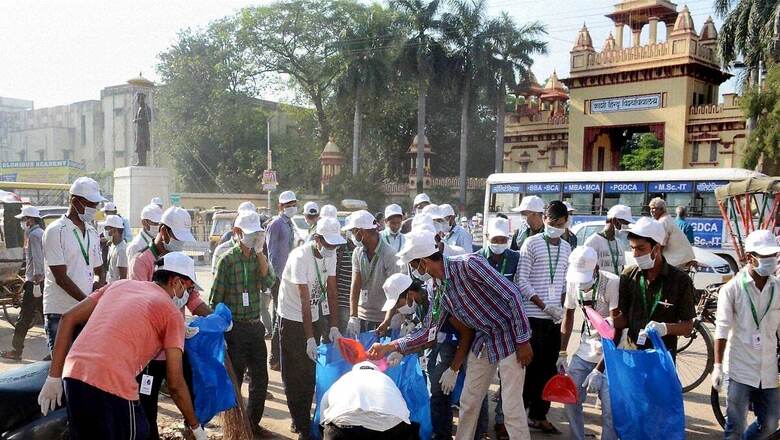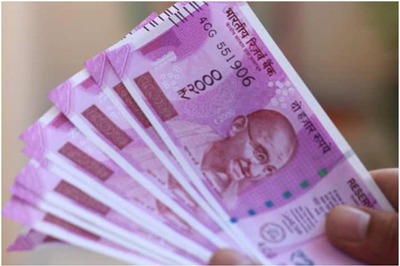
views
Launched on the Gandhi Jayanti of 2014, the Swachh Bharat Mission (SBM) has become synonymous with a cleaner and healthier India. Across the country, people are greeted with a synonymous jingle in the morning, “Swachh Bharat ka irada, irada kar liya humne, Desh se apne ye wada, ye wada kar liya humne”, as sanitation workers clean the streets and take out the trash from our houses.
The journey to making a Swachh Bharat is long and filled with challenges, but we have come far from where we started.
Here’s a look at some of the key accomplishments of the Swachh Bharat Abhiyan as it completes 10 years.
1. Open Defecation Free (ODF) Status for Villages: The most resounding victory of the SBM is the significant reduction in open defecation across rural India. Initiated in 2014, the mission aimed to make India ODF by 2019, a goal that spurred an unprecedented toilet construction drive. As per the Ministry of Drinking Water and Sanitation, the number of people practising open defecation in rural areas has fallen from 550 million to 320 million since the campaign’s inception. Notably, five states (Himachal Pradesh, Uttarakhand, Haryana, Sikkim and Kerala), over 200,000 villages, and 149 districts have been declared ODF.
This monumental shift wouldn’t have been possible without addressing the deep-rooted cultural and behavioural norms associated with sanitation. The SBM invested heavily in Information, Education, and Communication (IEC) campaigns and community engagement, fostering a sense of ownership and responsibility, among citizens.
2. Improved Toilet Coverage: The SBM’s focus on toilet construction has led to a substantial increase in access to sanitation facilities, particularly in rural areas, where coverage was historically low. Data from the National Family Health Survey (NFHS) highlights this positive trend. In 2004-05, only 45% of households had access to toilets. This figure rose to 61.1% in 2015-16 and further climbed to a remarkable 82.5% in 2019-21.
This increase in toilet coverage has a direct impact on public health, particularly for women and children, who are most vulnerable to the health risks associated with inadequate sanitation. It has also contributed to improved dignity and safety for women, who no longer have to venture out in the dark or face the threat of harassment when attending to their sanitation needs.
3. Reduction in Infant Mortality: Several studies have indicated a strong correlation between improved sanitation and a decline in infant mortality rates. A recent study published in the journal Nature, conducted by leading experts, found that the SBM has played a significant role in reducing infant and under-five mortality in India. The study, which analysed data from 35 states and 640 districts over a decade (2011-2020), found that the construction of toilets under the SBM have prevented an estimated 60,000-70,000 infant deaths annually.
The researchers found a clear inverse association between toilet access and child mortality, with districts having higher toilet coverage exhibiting lower infant and child mortality rates.
4. Rise of ODF Plus Villages: Building on the success of ODF status, the SBM has progressed to its second phase, focusing on ODF Plus villages. This initiative aims to ensure that villages not only achieve and maintain ODF status but also implement solid and liquid waste management systems. As of September 2023, over 4.4 lakh villages in India have declared themselves ODF Plus, marking a significant step towards comprehensive sanitation coverage.
This shift towards holistic waste management is essential for protecting the environment and ensuring a sustainable sanitation ecosystem. It involves the creation of infrastructure for the collection, segregation, and processing of waste, along with promoting community participation and behavioural changes towards responsible waste disposal practices.
5. Waste Management Initiatives: The SBM has also spurred several initiatives aimed at improving waste management, both in rural and urban areas. The emphasis is on the principles of Reduce, Reuse, and Recycle, promoting the segregation of waste at source and the development of sustainable waste processing solutions. The GOBARdhan scheme, for instance, supports the recovery and conversion of biodegradable waste into resources like biogas and bio-slurry, contributing to cleaner villages and a circular economy.
In terms of plastic waste management, over 2,380 Plastic Waste Management Units and 1,78,556 waste collection & segregation sheds have been set up across the country. Notably, 23 states/UTs are using waste plastic for road construction, demonstrating the potential for innovative solutions in waste utilisation.
6. Swachh Survekshan: To further boost sanitation efforts in urban areas, the Ministry of Urban Development introduced Swachh Survekshan, an annual cleanliness survey of cities. Initiated in 2016 with 73 cities, the survey has expanded to cover 500 cities with a population of 1 lakh and above. The rankings, based on various parameters including waste management, citizen feedback, and sanitation infrastructure, have fostered a spirit of healthy competition among cities, driving them to improve their sanitation performance.
Swachh Survekshan has not only created a visible impact on urban cleanliness but has also become a platform for citizen engagement and awareness.
7. Behavioural Change: Perhaps one of the most profound achievements of the SBM lies in its ability to bring about a behavioural shift in people’s attitudes towards sanitation. Through sustained IEC campaigns, community mobilisation, and the involvement of celebrities and public figures, the campaign has successfully made sanitation a national priority and instilled a sense of responsibility among citizens.
A study conducted by the Research Institute for Compassionate Economics (RICE) in 2018 highlighted the positive impact of the SBM on sanitation practices. The study found that the campaign had led to a significant increase in handwashing with soap and a decline in open defecation in the states surveyed.
SBM’s most significant legacy has been its ability to make sanitation a national conversation. The campaign’s success stands as a testament to the power of a people’s movement, guided by a clear vision and propelled by the collective will of a nation striving for a cleaner, healthier, and more prosperous future. The Swachh Bharat journey continues, carrying with it the promise of a cleaner and healthier tomorrow for every citizen of India.




















Comments
0 comment